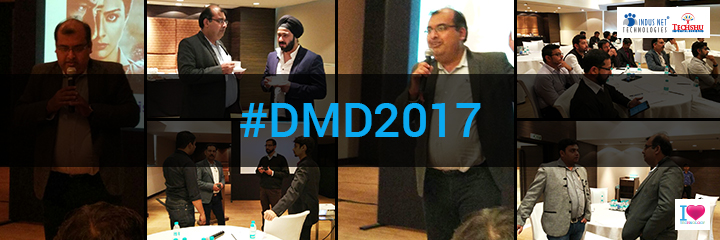
Must-read for CIOs this World Book Day
With great power comes great responsibility. This oft-quoted line might instantly remind us about the blockbuster Hollywood film Spider-Man, but this message holds true in the life of a CIO. A CIO needs to keep a hawk’s eye on the day-to-day IT operations, develop strategies to maintain an integrated IT architecture, balance IT budget and also motivate staff members. The role and responsibilities of a CIO are continuously evolving especially due to the rapid advancement in technology. With such workload, the CIO might not always have enough time to leaf through a book on a regular basis. But then, we all know that books are our best friends and books are a great tool to motivate, educated, entertain and build confidence. So, it’s important to take time out for yourself and read. At times, there’s no harm taking a quick reading break in the middle of a workday. At Indus Net Technologies, we have a culture of reading books and we inculcate the habit of reading among our employees too. On World Book and Copyright Day on April 23, Indus Net Technologies has compiled a list of books CIOs can read, get inspired from or add to their already existing collection. 1. Be the Business: CIOs in the New Era of IT Author: Martha Heller The book, by Martha Heller, the founder and President of Heller Search Associates, a recruiting firm specializing in CIO, comprises profiles of CIOs, quotes and their interviews. It is exciting and appealing to read how CIOs are leading the way in creating an IT climate where technology belongs to everyone. goo.gl/drAX49 2. Digital Vortex: How Today’s Market Leaders Can Beat Disruptive Competitors at Their Own Game Authors: Jeff Loucks, Andy Norohna, Dr James Macaulay and Michael Wade This 266-pages hardcover on digital disruption gives a detailed overview of the business best practices. The book gives a thorough understanding of how to identify a company’s disruptive competitors. goo.gl/GFvg5t 3. Wolf in CIO’s Clothing Author: Tina Nunno Running a business is not an easy task and at times, a CIO needs to take on difficult business decisions. Gartner analyst Tina Nunno makes an interesting and analytical observation in this book, where she explains how at times people at the helm of power turn grey depending on situations to make their businesses profitable. She draws metaphorical comparisons between Machiavellians and wolves. It’s an interesting read. goo.gl/1uKdkn 4. Meatball Sundae: Is Your Marketing out of Sync? Author: Seth Godin Just like his blogs, this book chronicles important topics in lucid language but in entertaining and captivating ways. Meatball Sundae is a must-read, which comprises 14 trends that no marketer can overlook. You are bound to go with the flow of this language. goo.gl/6Wgyl3 5. Information Architecture: For the Web and Beyond Authors: Jorge Arango, Louis Rosenfeld, and Peter Morville Since all the three authors are Information Architecture (IA) consultants, this book provides a detailed introduction to IA and also the process, strategies, and implementation needed for IA. goo.gl/7GMrZY 6. The Art of Scalability: Scalable Web Architecture, Processes, and Organizations for the Modern Enterprise Authors: Michael T Fisher and Martin L Abbott Exquisitely researched and informative guidebook with the best practices in technology and processes needed to build a scalable organization. goo.gl/P6SXwq 7. Don’t Make Me Think, Revisited: A Common Sense Approach to Web Usability Author: Steve Krug You will be hooked onto the book from the very first page, thanks to Steve Kurg’s impeccable story-telling style and witty yet educative information. This book is an absolute favourite for anyone who’s interested in web designing. goo.gl/GcdXde 8. Growing Your CIO Career: How CIOs Can Work With the Entire Company in Order to Be Successful Author: Jim Anderson What are the traits that make for a successful CIO? Who’s a CIO’s best friend? This book gives a vivid portrayal of what exactly goes in the life of a CIO and whether MBA is needed to become a successful CIO. goo.gl/9eapiW 9. How To Win Friends & Influence People Author: Dale Carnegie One of the Time magazine’s 100 most influential books of 2011, this is one of the most popular self-help books available in the market. A compelling book, this helps one to understand the behaviour of the people and also how to improve communication and business skills. goo.gl/7wdtUn 10. Letting Go of the Words: Writing Web Content that Works (Interactive Technologies) Author: Ginny Redish Renowned usability writer and consultant Ginny Redish presents a comprehensive and exhilarating look at anything which deals with writing on the web. Almost like a Bible for the web content writers and content strategists. goo.gl/Lvl0UY 11. The Magic of Thinking Big Author: David J. Schwartz goo.gl/tKJkAq This incredibly popular self-help book has sold over 4 million copies and comprises motivational pep talks on life, positivity and future. An easy-read, the book has practical examples, which will excite the readers to lead a happy and fulfilled life. 12. Technology vs Humanity: The Coming Clash Between Man and Machine Author: Gerd Leonhard Are we heading to an era where technology will completely dominate humanity, or should there be a sustainable balance between humanity and technology? This thought-provoking book by futurist Gerd Leonhard debates the ethics of technology and the disruptive potential and development of technology. goo.gl/wh3Ns2 13. The Hard Thing about Hard Thing: Building a Business When There are No Easy Answers Author: Ben Horowitz Renowned American business and investor Ben Horowitz gives his first-hand experiences on building a technology business, from scaling it up, managing it to leading the way. The book has relatable content with good humour and learning. goo.gl/mHgpQJ 14. The Industries of the Future Author: Alec Ross American technology policy expert, Alec Ross was also the Senior Advisor for Innovation to Secretary of State Hillary Clinton during her term as Secretary of State. He came up with an arresting and influential book, which explores the development in the fields of big data, cyber security, robotics and how these fields will impact our economic future.






